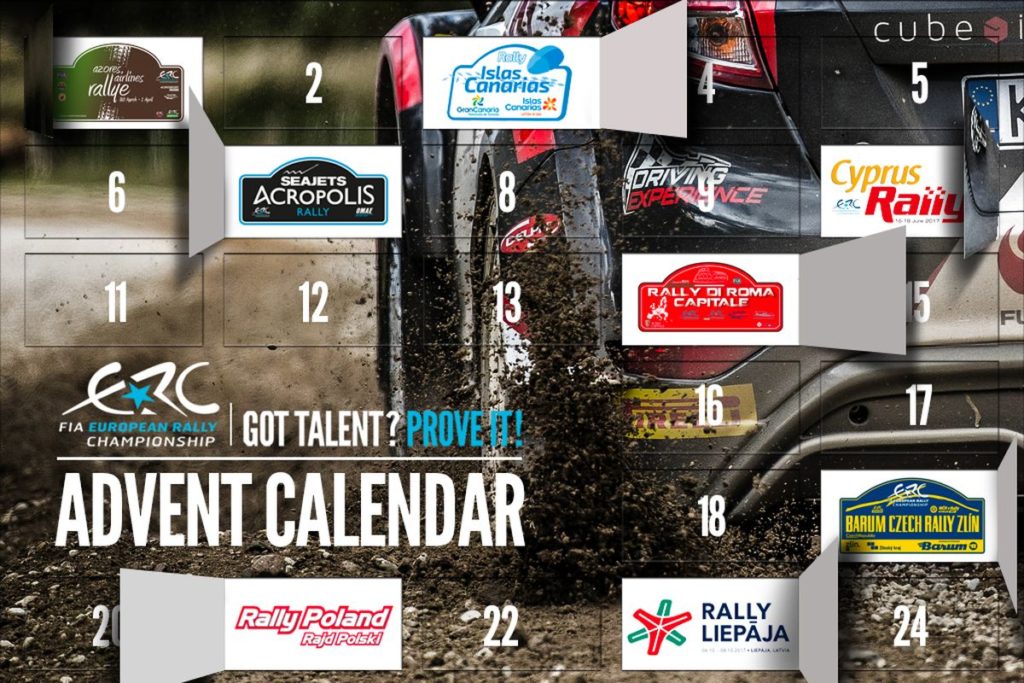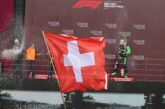 The FIA European Rally Championship will continue to feature eight events next season after the switch to a smaller schedule in response to feedback from teams proved a success when trialled in 2017.
The FIA European Rally Championship will continue to feature eight events next season after the switch to a smaller schedule in response to feedback from teams proved a success when trialled in 2017.
Ratified at a meeting of the FIA World Motor Sport Council in Paris yesterday (6 December) the calendar runs from March to October to ensure a regular flow of rallies. ERC season 66 begins with the Azores Airlines Rallye on the Portuguese mid-Atlantic Ocean archipelago from 22-24 March and concludes on Latvia’s Baltic coast from 12-14 October for Rally Liepāja, where five coveted FIA titles were decided this year. Two ERC mainstays, Rally Islas Canarias and Barum Czech Rally Zlín, occupy their now traditional early May and late August slots respectively, while the Cyprus Rally keeps its mid-June date, two weeks after the legendary Acropolis Rally in Greece*. Rally Poland returns to the ERC roster for the first time since triple European champion Kajetan Kajetanowicz won his home event in 2013, while there’s a July date for Rally di Roma Capitale, which brought Italy back to the ERC fold last September.
The gravel-based Rally Poland takes over from the all-asphalt Rally Rzeszow as the Polish ASN’s European championship counter for the season ahead when it celebrates its 75th edition.
Structured once again in response to calls from drivers and teams who were keen to cap their number of competitive outings at between six and eight events, the ERC calendar includes three rallies on asphalt and five on gravel (three on each surface for ERC Junior Under 27 and ERC Junior Under 28). There are no clashes between the ERC and world championship schedules.
Drivers in ERC1 and ERC3 count their best six scores from eight, while it’s four from six in ERC Junior Under 28 and ERC Junior Under 27. For the first time, ERC2 and the ERC Ladies’ Trophy competitors will count their best four scores from eight. The FIA European Rally Championship for Teams, which was restructured to great effect in 2017, will count the best six scores from eight by registered entrants.
 FIA European Rally Championship calendar 2018
22-24 March: Azores Airlines Rallye (Portugal, gravel) ERC Junior
3-5 May: Rally Islas Canarias (Spain, asphalt) ERC Junior
1-3 June: Acropolis Rally (Greece, gravel)*
15-17 June: Cyprus Rally (Cyprus, gravel)
20-22 July: Rally di Roma Capitale (Italy, asphalt) ERC Junior
24-26 August: Barum Czech Rally Zlín (Czech Republic, asphalt) ERC Junior
21-23 September: Rally Poland (Poland, gravel) ERC Junior
12-14 October: Rally Liepāja (Latvia, gravel) ERC Junior
*Subject to signing of event promoter agreement
FIA European Rally Championship calendar 2018
22-24 March: Azores Airlines Rallye (Portugal, gravel) ERC Junior
3-5 May: Rally Islas Canarias (Spain, asphalt) ERC Junior
1-3 June: Acropolis Rally (Greece, gravel)*
15-17 June: Cyprus Rally (Cyprus, gravel)
20-22 July: Rally di Roma Capitale (Italy, asphalt) ERC Junior
24-26 August: Barum Czech Rally Zlín (Czech Republic, asphalt) ERC Junior
21-23 September: Rally Poland (Poland, gravel) ERC Junior
12-14 October: Rally Liepāja (Latvia, gravel) ERC Junior
*Subject to signing of event promoter agreement
ERC Co-ordinator Jean-Baptiste Ley said: “We’re very pleased to announce the FIA European Rally Championship calendar for the 2018 season when we will continue to run eight events in response to feedback from our drivers and teams. It says a great deal about the popularity and success of the ERC, in particular the restructured ERC Junior Championship and European Rally Championship for Teams, that we will continue to work with the same national federations as we did in 2017 and we look forward to strengthening those ties and making improvements wherever possible for our mutual benefit.”
Promoted by Eurosport Events under a 10-year agreement with motorsport’s world governing body and run first in 1953, the FIA European Rally Championship is the ultimate training ground for young hopefuls aiming for the top. Providing a clear path of progression from national level to the world stage, the oldest international rally series in existence is also open to all-comers, meaning age is no barrier to competing.
ERC RALLIES IN 100 WORDS
Azores Airlines Rallye (22-24 March) Based on the mid-Atlantic archipelago’s largest island of São Miguel, the rally celebrated its half-century in 2015 and remains one of the most spectacular events on the international calendar. Stages criss-cross breath-taking scenery and lush countryside and are characterised by their sandy surface and narrow and undulating nature. And because the timed tests are often no wider than the width of a car, there is simply no margin for error, particularly on the Sete Cidades test along the rim of a volcanic crater lake. Changeable weather is also a factor with conditions switching from sunshine to showers and fog patches.
Rally Islas Canarias (3-5 May) With the stages climbing and descending at a frequent rate, drivers pay close attention to corner speed and lines to ensure optimal momentum is maintained, while precise car set-up and pacenote accuracy are vital. One of the notable features of the sealed stages is the abrasive surface, constructed partly from volcanic lava. It means grip levels are high and remain constant if it rains, although tyre wear can increase. However, with the opportunity to take ‘cuts’ through corners limited, the roads remain relatively debris-free. Returning to the ERC schedule in 2016, it’s a rally big on challenge and spectator numbers.
Acropolis Rally (1-3 June) For more than 60 years, the Acropolis Rally has made heroes and broken hearts. Throughout that time, its legendary status has remained undiminished with the 2017 edition offering the usual mix of triumph (for Kajetan Kajetanowicz) and despair (for Nikolay Gryazin, who was leading when his car was gutted by fire). An ERC regular until 1968, the event returned to the European championship in 2014 when Loutraki on the banks of the Gulf of Corinth hosted the 60th running, a mixed-surface affair. Now run in partnership with the OMAE Greek federation on gravel only, Lamia has been home since 2016.
 Cyprus Rally (15-17 June) Since 1970, the Cyprus Rally has put car and crew to a significant test. And while the current format is a little less taxing than it once was, underestimating the challenging nature of this rallying heavyweight would be a big mistake. To mark its return to the ERC roster in 2014 for the first time since 1999, a ground-breaking street stage through the United Nations-controlled Buffer Zone between Nicosia’s Greek Cypriot and Turkish inhabited areas was organised and generated considerable interest. Although fundamentally a gravel rally, Tarmac sections feature while the June date makes for punishing ambient and ground temperatures.
Cyprus Rally (15-17 June) Since 1970, the Cyprus Rally has put car and crew to a significant test. And while the current format is a little less taxing than it once was, underestimating the challenging nature of this rallying heavyweight would be a big mistake. To mark its return to the ERC roster in 2014 for the first time since 1999, a ground-breaking street stage through the United Nations-controlled Buffer Zone between Nicosia’s Greek Cypriot and Turkish inhabited areas was organised and generated considerable interest. Although fundamentally a gravel rally, Tarmac sections feature while the June date makes for punishing ambient and ground temperatures.
Rally di Roma Capitale (20-22 July) The progression of this exciting asphalt event, organised and promoted by Motorsport Italia, has been remarkable. Having run for the first time in 2013, Rally di Roma Capitale made its ERC debut in 2017 as Italy returned to the European championship for the first time since 2013 when Rallye Sanremo was on the calendar. It proved a big hit with a driving parade through the centre of Rome, a spectacular spectator stage around the Palazzio della Civiltà del Lavoro in the EUR district, followed by two days of action-packed rallying on stages to the east and south-east of the capital.
Barum Czech Rally Zlín (24-26 August) Ever-present in the ERC since the championship’s streamlining in 2004, Barum Czech Rally Zlín is based in the South Moravian university city, 300 kilometres south of the Czech capital Prague. It is a Tarmac test like no other due to the bumpy and sometimes broken nature of the road surface. To add to the challenge, several stages feature high-speed blasts through forests and intermittent showers are always possible. While the weather might be hard to predict, huge numbers of fans follow the action, especially on the opening night-time Zlín superspecial stage. The rally has a long-term contract with the ERC.
Rally Poland (21-23 September) One of the world’s oldest rallies is back on the ERC calendar in 2018 after a five-year break as Rally Poland replaces Rally Rzeszow as the country’s round of the European championship for its 75th edition. First run in 1921, Rally Poland’s home since 2005 has been Mikołajki in the picturesque Mazurian lake district, a three-hour drive north from the capital Warsaw, where high-speed all-gravel stages are commonplace. And it was in Mikołajki where Kajetan Kajetanowicz first emerged as a major force in the ERC, taking the win in 2013 prior to beginning his record-breaking title treble sequence in 2015.
Rally Liepāja (12-14 October) The brainchild of rally driver turned promoter Raimonds Strokšs and first run to great acclaim in 2013, Rally Liepāja was originally a winter event but switched to the autumn for 2016. The new date effectively made for an all-new rally as crews adjusted to gravel stages free of snow and ice. Although the time of year had changed, the high-speed stages in western Latvia continued to thrill drivers and spectators alike. And with its new format now firmly established, this forward-thinking rally serves as a fitting season finale with Liepāja proving to be a popular destination for fans and competitors.
Press release ERC
]]>





